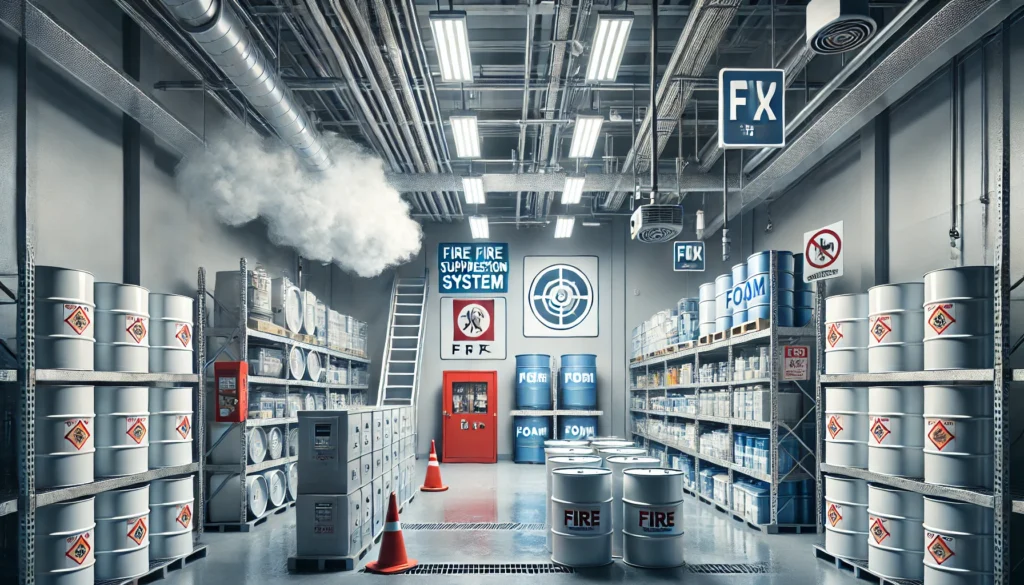Chemical storage facilities present unique fire hazards that require specialized suppression solutions. Selecting the appropriate system depends on the type of chemicals stored, potential fire risks, and environmental considerations. This guide compares Medium Velocity Water Spray (MVWS) and Water Mist Fire Suppression Systems, along with other recommended fire suppression methods and chemical plant fire protection systems for various chemical storage scenarios.
1. Understanding Fire Risks in Chemical Storage Facilities
Fires in chemical storage facilities can be classified into different categories based on the nature of stored materials:
Class A Fires: Solid combustibles such as wood, paper, and plastics.
Class B Fires: Flammable liquids, including fuels, solvents, and alcohols.
Class C Fires: Electrical fires caused by malfunctioning equipment, control panels, and pumps.
Class D Fires: Combustible metals like lithium, sodium, and magnesium (which react dangerously with water).
A proper risk assessment is essential before choosing a fire suppression system.
2. Comparing Fire Suppression Systems for Chemical Storage
| Feature | Medium Velocity Water Spray (MVWS) | Water Mist Fire Suppression |
|---|---|---|
| Best For | General storage with solid combustibles (Class A & B). | Sensitive areas containing electrical or water-reactive chemicals. |
| Water Requirement | High water volume required, increasing runoff risks. | Uses up to 90% less water, minimizing damage. |
| Cooling Effect | Reduces fire intensity and prevents spread. | Rapid cooling and evaporation prevent fire escalation. |
| Oxygen Displacement | No oxygen displacement capability. | Forms steam to displace oxygen, aiding fire suppression. |
| Electrical Equipment Safety | Not recommended for electrical areas. | Safe for data centers, control rooms, and switchgear areas. |
| Environmental Impact | Risk of contaminated water runoff. | Minimal runoff, reducing environmental impact. |
| Installation Cost | Lower initial cost, suitable for industrial warehouses. | Higher cost due to specialized nozzles and high-pressure components. |
3. Recommended Fire Suppression Systems for Different Chemical Storage Areas
Choosing the right system depends on the materials stored. Below is a detailed breakdown of the best suppression solutions per storage type:
| Storage Type | Recommended Fire Suppression System | Why? |
| Flammable Liquids (Class B, e.g., fuels, solvents, paints) | High Velocity Water Spray (HVWS) + Foam Suppression | Foam blankets fuel surfaces, preventing re-ignition. |
| General Chemical Storage (Class A, solid combustibles) | MVWS + Automatic Sprinkler System | Cools materials and prevents fire spread. |
| Electrical Equipment & Control Rooms | Water Mist or Clean Agent System (FM-200, CO₂) | Non-damaging to sensitive electronics. |
| Water-Reactive Chemicals (Class D, e.g., lithium, sodium, magnesium) | Dry Chemical Suppression (Powder-based system) | Prevents dangerous water reactions. |
| Toxic or Corrosive Chemical Storage | Water Mist + Inert Gas Suppression (Inergen, CO₂) | Minimizes toxic runoff and ensures fast suppression. |
4. Designing a Fire Suppression Layout for a Chemical Warehouse
1. Storage Areas
- MVWS nozzles installed for combustible chemical storage zones.
- HVWS with a foam system deployed for areas storing highly flammable liquids.
2. Electrical & Equipment Rooms
- Water Mist or FM-200 system installed to protect control panels and electrical infrastructure.
3. Hazardous Chemical Zones
- Dry chemical suppression in areas storing water-reactive metals.
- Gas-based suppression (CO₂, Inergen) to avoid contamination risks.
4. Nozzle & Piping Configuration
- Overhead water mist or MVWS nozzles placed strategically at 2-3 meter intervals.
- High-risk areas require isolation zones equipped with automatic fire doors.
